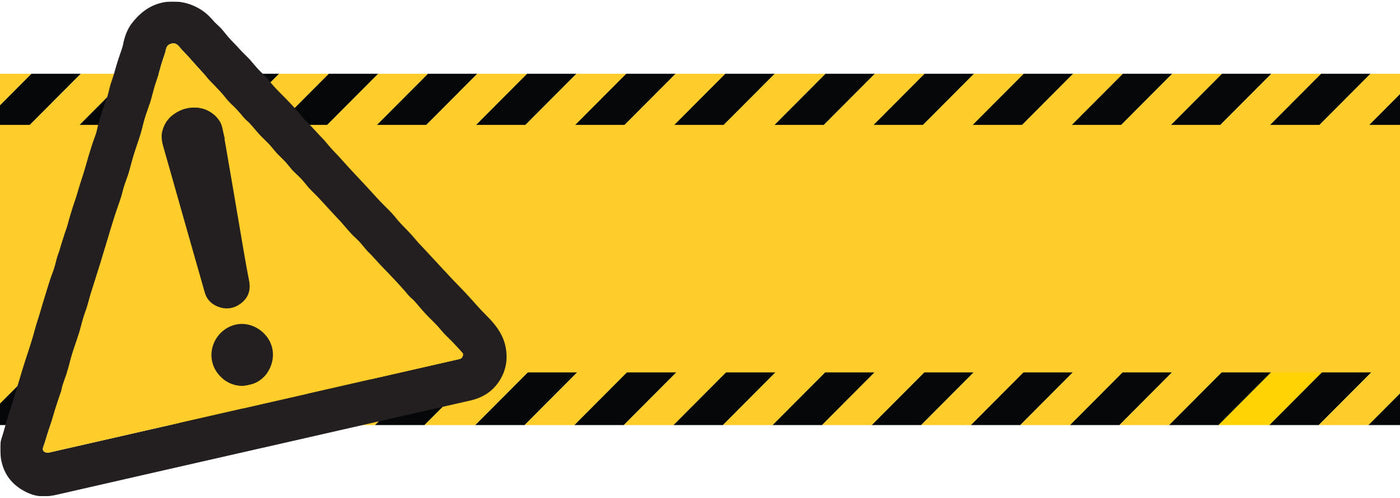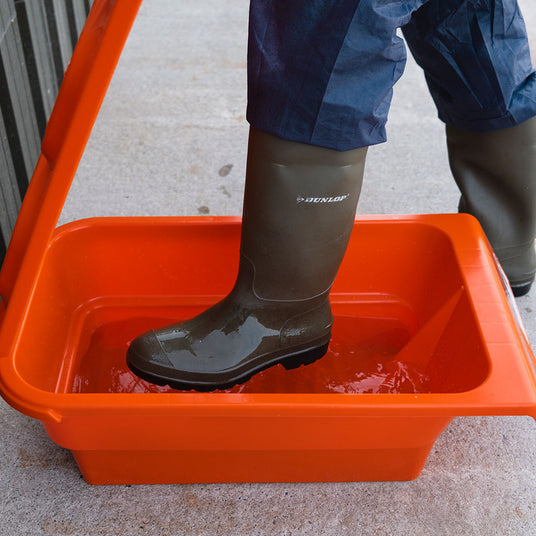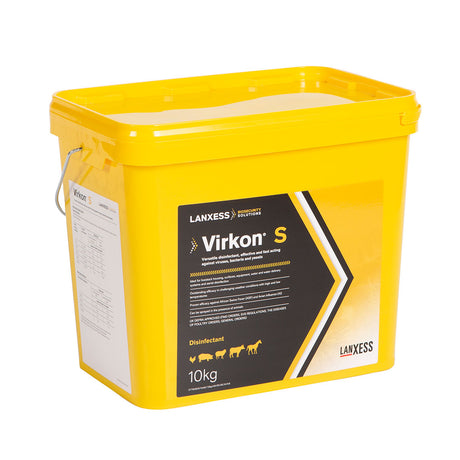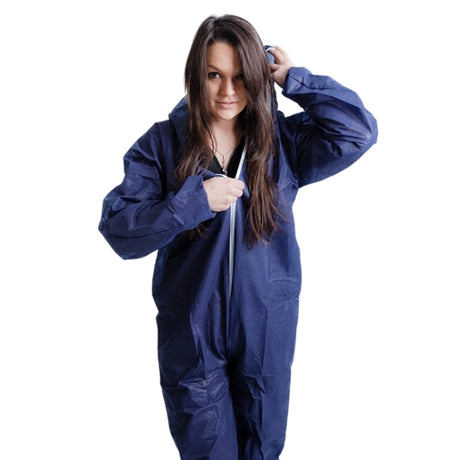Why Protecting Your Farm from Foot and Mouth Disease Matters Now
With recent foot and mouth disease outbreaks in Europe moving closer to UK shores, farmers need to take urgent steps to protect their livestock. The disease spreads rapidly and can devastate your farm within days. Recent cases in Germany, Hungary, and Slovakia serve as stark reminders of how quickly this disease can reappear, even in countries that have been disease free for decades.
This guide provides practical, straightforward advice on preventing and controlling foot and mouth disease, with a special focus on effective disinfection using Virkon and other approved solutions. Whether you're a small family farm or a large commercial operation, these measures could save your livestock and livelihood.
Understanding Virkon: Your Front-Line Defence Against Foot and Mouth Disease
Virkon S has become the go-to disinfectant for many UK farmers concerned about foot and mouth disease. It's highly effective against the FMD virus and is approved by Defra for use during Foot and Mouth Disease Orders.
The active ingredient in Virkon S is potassium monopersulfate (KMPS), a powerful oxidising agent that works by producing chlorine when mixed with water. This makes it extremely effective at killing viruses, bacteria, and fungi – including the foot and mouth disease virus.
How to Mix Virkon S Correctly
Getting the right concentration is crucial for effectiveness:
- Standard preventative use: Mix at 1% solution (100g of Virkon S in 10 litres of water)
- Defra approved rate for FMDO: 1:1300 (13g of Virkon S in 10 litres of water)
Important mixing tips:
- Always add the powder to the water, not the other way around
- Use tepid water to help the powder dissolve completely
- Stir gently – harsh stirring may prevent complete dissolution
- After initial stirring, leave for a couple of minutes, then stir gently again
Common Mistakes to Avoid with Virkon S
Many farmers make these costly errors when using Virkon:
- Making solutions too strong: Contrary to what you might think, stronger isn't better. Excessive concentrations cause the active ingredient to burn itself out quickly, making the solution ineffective.
- Storing mixed solution in sunlight: UV rays deactivate KMPS. Never store mixed Virkon S in clear or translucent containers exposed to sunlight. A clear IBC tank is not suitable for storage.
- Using contaminated solutions: Organic matter like mud or manure renders the disinfectant ineffective. Change solutions regularly and keep them clean.
- Not allowing enough contact time: Virkon S needs time to work. Boot dips should allow full immersion, and surfaces need to remain wet with the solution for the recommended contact time.
Virkon LSP: A Liquid Alternative
If you prefer a liquid disinfectant, Virkon LSP offers an excellent alternative. This broad-spectrum synthetic phenolic disinfectant is:
- Effective against viruses, bacteria and fungi
- Works in a wide range of temperatures
- Effective even in the presence of organic matter
- Defra approved for Foot and Mouth Disease Orders at 1:1100 (10ml in 10 litres of water)
- Suitable for equipment, boot dips, vehicle wheel dips and thermal fogging
For equipment, boot dips and vehicle spray disinfection, use at 1:100 (100ml per 10 litres of water).
Setting Up Effective Disinfection Points Around Your Farm
Boot Baths: Your First Line of Defence
Boot baths or dips are crucial for preventing disease spread between different areas of your farm. People's footwear is one of the most common ways that foot and mouth disease spreads between farms and farm buildings.
For maximum effectiveness:
- Use lidded boot baths rather than open containers to prevent dilution by rainwater and degradation from UV light
- Position baths at all entry points to your farm and between different livestock areas
- Clean boots thoroughly before dipping – use a brush and water to remove all visible dirt first
- Change the solution every 3-4 days, or immediately if visibly contaminated
- Consider using a boot bath with integral brushes for easier cleaning
How to Get the Most Out of Disinfection Mats on Your Farm
Disinfection mats are one of the simplest yet most effective tools for preventing foot and mouth disease from entering your farm. When used properly, they create a crucial barrier at entry points, ensuring vehicles and people don't bring disease onto your property. Here's how to use them correctly:
Choosing the Right Mat for Each Location
There are several types of disinfection mats designed for different purposes:
- Pedestrian mats (typically 0.45m x 0.60m or 0.60m x 0.90m) for walkways and building entrances
- Vehicle mats (typically 1.20m x 2.00m with thicker 40mm foam) for farm entrances and transitional areas
Place pedestrian mats at all building entrances where people move between different areas of livestock. Vehicle mats should be positioned at farm entrances where delivery vehicles and farm machinery enter and exit.
Proper Setup and Maintenance of Disinfection Mats
For your mats to work effectively:
-
Choose the right location: Place mats on even surfaces without any protruding objects that could damage the underside. Specially prepared depressions or troughs work well for long-term placement.
-
Fill correctly: Pour disinfectant solution slowly into the black net covering, allowing the foam to absorb the liquid evenly. New foam may initially appear slightly deformed compared to the cover but will adapt to the mat's shape with use.
-
Use appropriate disinfectants: Only use products specifically intended for disinfection mats and mix them at the concentrations recommended by manufacturers. Never mix different chemicals in a single mat!
-
Winter precautions: For temperatures below 0°C, add an antifreeze product such as glycol to prevent the disinfectant from freezing and becoming ineffective.
-
Regular maintenance: Keep mats saturated with disinfectant and replace or supplement solutions according to the manufacturer's instructions. Regularly sweep off larger debris that could damage the mat during use.
Vehicle Passage Over Disinfection Mats
For vehicle mats to remain effective and undamaged:
- Vehicles must reduce speed to no more than 3mph when passing over mats (first gear without accelerating)
- Place speed limit signs at the entrance to inform drivers
- Strictly avoid accelerating, turning, or braking while on the mat, as these actions can cause significant damage
- Train all farm staff and regular visitors on proper use of the mats
- For larger farms, consider creating dedicated disinfection stations with clear instructions
Remember that a damaged or dry disinfection mat provides a false sense of security while offering no protection against disease. Regular checks throughout the day ensure your mats remain an effective barrier against foot and mouth disease.
Creating a Complete Farm Biosecurity System
Effective disinfection is just one part of a comprehensive approach to preventing foot and mouth disease. You can read our guide on preventing the spread of foot and mouth here. Your farm biosecurity system should also include:
Clear Signage and Instructions
Place prominent signs at all farm entrances with clear instructions for visitors:
- Where to park
- Disinfection requirements
- Areas that are off-limits
- Who to contact upon arrival
Visitor Protocols
Establish strict procedures for all visitors:
- Maintain a visitor log with contact details and previous farm visits
- Provide clean farm clothing and boots if possible
- Restrict access to essential areas only
- Ensure visitors understand and follow all biosecurity measures
Staff Training
Everyone working on your farm should understand:
- The risks of foot and mouth disease
- Proper disinfection procedures
- Early signs of disease to watch for
- Immediate actions if disease is suspected
Regular Monitoring and Maintenance
Even the best biosecurity system fails without regular checks:
- Inspect fences and boundaries regularly
- Check disinfection points daily
- Monitor livestock for any early signs of disease
- Refresh disinfectant solutions according to schedule
- Keep records of all biosecurity activities
What to Do If You Suspect Foot and Mouth Disease
If you notice symptoms that could indicate foot and mouth disease:
- Isolate affected animals immediately
-
Call your vet or the Animal and Plant Health Agency straightaway
- England: 03000 200 301
- Scotland: 01224 337550
- Wales: 0300 303 8268
- Halt all movement on and off your farm
- Increase disinfection measures throughout your farm
- Prepare records of recent animal movements and farm visitors
Early reporting is essential. The sooner the disease is detected, the better the chances of containing it before it spreads further.
Conclusion: Your Role in Protecting UK Farming
Every farmer has a responsibility to maintain strict biosecurity. The 2001 foot and mouth outbreak cost the UK economy over £8 billion and led to the culling of more than 6 million animals. A single case on your farm could trigger another national crisis.
By implementing proper disinfection procedures with products like Virkon S, maintaining effective biosecurity measures, and staying vigilant, you're not just protecting your own livestock – you're helping to safeguard the entire UK agricultural industry.
Remember: Prevention is always better than cure, especially when it comes to foot and mouth disease.
For more information on protecting your farm from foot and mouth disease, contact your local Animal and Plant Health Agency office or visit the Defra website.



















